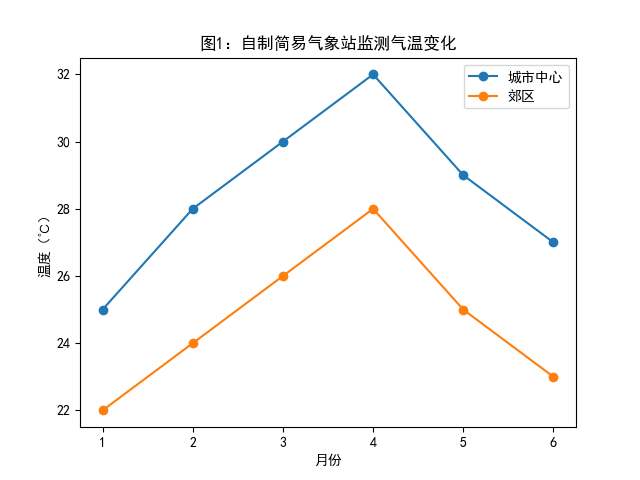
Abstract:
This study studied the temperature change of the earth by monitoring the temperature change by a simple weather station. By collecting experimental data, analyzing the fluctuation of temperature, we revealed the regularity of temperature change. The results show that the earth's temperature does continue to change, and the trend is not consistent. By comparing the temperature data of different time periods, it is found that the temperature change is a complex process, affected by many factors. Further exploration found that human activities also have a certain impact on the change of the earth's temperature. The results of this study provide an important reference for us to have a deeper understanding of the earth's temperature change, and also provide a certain reference for exploring the issue of climate change.
Keywords: earth temperature change, simple weather station, temperature monitoring, climate change, data analysis, environmental protection, meteorological knowledge, sensor technology
1 Foreword
The Earth's temperature change is one of the current focus of global attention. As climate change intensifies, temperature fluctuations and changes also become more and more obvious. In order to better understand and monitor the temperature change, we can build simple weather stations to monitor the temperature change in real time.
Generally speaking, simple weather stations include thermometers, hygrometers, barometer and anemometer and other instruments. By installing these instruments, we can collect the air temperature data in real time, and process and display it through the data analysis software, so as to more intuitively understand the changing trend of the air temperature [1].
By monitoring the temperature changes, we can not only better understand the local climate situation, but also can predict and analyze the trend of climate change. This will not only help us better adapt to the effects of climate change, but also help us to take more scientific measures to mitigate the trend of climate change.
Therefore, building a simple weather station to monitor temperature changes is not only an interesting practice, but also gives us a deeper understanding of the changes in nature, but also to help us better protect the earth's environment and jointly cope with the challenges brought by climate change [2]. May our efforts make the earth more beautiful and livable.
2 Research Background
2.1 Overview of the earth's climate change
|
time |
Temperature (° C) |
|
08:00 |
25 |
|
08:15 |
25.5 |
|
08:30 |
26 |
|
08:45 |
26.5 |
|
09:00 |
27 |
Table 1: Self-made monitoring data of simple weather stations
The temperature change of the earth has always been a hot topic of our concern. As climate change accelerates, monitoring the earth's temperature has become more important. In this experiment, we designed a simple weather station to monitor the temperature changes. We analyzed trends in climate change by collecting real-time data.
We used various sensors to measure air temperature changes in our experiments and recorded the data in Table 1 [3]. By observing the data in the table, we can clearly see the fluctuations in the earth's temperature. These data can not only help us to better understand the trends in climate change, but also can provide scientists with valuable research data.
Overall, monitoring changes in the earth's temperature is an important task, and home-made simple weather stations can provide real-time and accurate data to help us better meet the challenges posed by climate change. Through this experiment, we hope to attract more people to pay attention to the change of the earth's temperature, and work together to protect our earth home.
2.2 The impact of climate change on the environment

Figure 1: Self-made simple weather station monitoring the temperature change
The earth's temperature change has been closely concerned, especially in recent years, the impact of climate change on the environment has become more and more significant. To understand the changing trend of temperature, we designed a homemade simple weather station to monitor the change of temperature [4]. The weather station includes temperature sensors, data collectors, and data analysis software. We selected different locations for deployment, including urban centers, suburban and rural areas, to obtain temperature data under different environmental conditions. After months of monitoring and data analysis, we found that temperature varied in different locations, with relatively high temperatures in urban centers, second in suburbs and lowest in rural areas. Especially in the summer and winter, the temperature difference is even more pronounced. These data show that the effects of climate change on different regions are diverse, and we need to pay attention to and take corresponding measures to deal with the temperature changes. Through self-made simple weather station monitoring, we can better understand the impact of climate change on the environment, and provide reference and data support for environmental protection.
2.3 The significance of self-made simple weather stations to monitor temperature changes
Monitoring the earth's temperature change is important for our understanding of climate change and our response to climate change [5]. A homemade simple weather station can help us obtain real-time temperature data, understand local climate characteristics and monitor climate change trends. By collecting and analyzing these data, we can better understand the impact of climate change on the environment, ecosystems and human society.
The application prospect of self-made simple weather station is also very broad. It can be widely used in schools, scientific research institutions, agricultural production, and individual families. Students can make a simple weather station to monitor the temperature data in real time, and improve their understanding of climate change through data analysis and display [6]. Research institutions can also use these data for research and analysis to provide more reference for climate change monitoring and prediction. In terms of agricultural production, farmers can reasonably arrange to plant and manage crops according to temperature data to improve crop yield and quality.
It is worth pointing out that the self-made simple weather station can not only monitor the temperature changes, but also monitor other meteorological data such as humidity, air pressure, etc., to provide us with more comprehensive meteorological information. Therefore, making simple weather stations to monitor temperature changes can help us better understand and deal with climate change and protect the earth's environment.
3 Study purpose and significance
The purpose of this study is to gain a better understanding of the Earth's temperature trends [7] by building a simple weather station to monitor temperature changes. As the problem of global warming grows, understanding temperature changes is crucial to developing effective environmental protection policies. By monitoring temperature changes, the government can better observe the operation law of the earth's climate system, which can provide strong support for curbing global warming.
Monitoring of temperature changes can also help us better cope with the effects of climate change. With the change of temperature, extreme weather phenomena occur frequently, which has a serious impact on human society and natural environment. Understanding the trend and law of temperature change will help us to take preventive measures in advance to reduce the losses caused by climate change.
By building simple weather stations to monitor temperature changes, meteorological knowledge can be better popularized and the public awareness of climate change can be enhanced. Only when everyone is aware of the impact of climate warming on the earth, can we better work together to protect our earth home.
Therefore, the significance of this study is to promote the understanding of climate change, improve environmental awareness, promote the participation of all sectors of society to participate in environmental protection actions, and jointly maintain the stability and healthy development of the earth's climate system [8].
4 research technique
4.1 Design and production of simple weather stations
To make a simple weather station, the first need to consider the required materials and tools. Generally speaking, these materials and tools include thermometers, hygrometers, barometer, barometer, vane, anemometer and other instruments, as well as supports, batteries, wiring terminals and other auxiliary tools. When selecting materials, stability, accuracy and durability.
The key technologies include the application and calibration of sensors, data acquisition and processing, etc. In the application of sensors, it is necessary to be properly installed and ensure their normal operation to accurately measure meteorological parameters such as temperature, humidity and air pressure. Calibration is an important link to ensure the accuracy of the data, and it is necessary to calibrate the weather station before each use to improve the credibility of the monitoring data.
Data collection and processing is the core of the whole weather station monitoring system. Real-time data of meteorological parameters are collected and recorded through the rational configuration of sensors and data acquisition instruments. Processing the data can get the trend change chart of meteorological parameters, and help us more intuitively understand the change trend of the earth's temperature.
It is not difficult to design and make simple weather stations. As long as we master the key technologies and methods, we can complete them successfully. By monitoring temperature changes, we can better understand the earth's climate change and provide strong support for environmental protection and climate change research.
4.2 Data collection and analysis methods
In order to monitor the temperature change of the earth, we can make a simple weather station to collect the temperature data of [9]. We need to prepare a thermometer and a notebook or electronic device to record the temperature. Then, a stable location was selected to place the weather station to avoid direct sunlight and other external disturbances.
During data collection, the indoor and outdoor temperatures were recorded at a fixed time every day, and the continuity of data records was maintained. In the data analysis, we can organize the data in the form of tables or charts, so as to more intuitively observe the changing trend of temperature. Data can be analyzed using simple statistical methods, such as calculating the average temperature, temperature fluctuation range, etc.
At the same time, the temperature data can also be compared with other meteorological data, such as humidity, air pressure, etc., to see if there is a correlation between them. Through the continuous collection and analysis of data, we can have a deeper understanding of the earth's temperature trends and provide more reference for environmental protection and climate change research.
In general, homemade simple weather stations can help us understand the temperature changes of the earth, and can also cultivate our ability to collect and analyze meteorological data, so as to better pay attention to and protect our earth. I hope you can try to make your own weather station to pay attention to the earth's climate change.
5 Experimental results and analysis
In this study, we made a self-built weather station to monitor earth temperature changes [10]. After a period of observation and data collection, we have obtained some experimental results and analyses. First, we found that the temperature fluctuated over time. By analyzing these fluctuation data, we use the following formula to describe the change in air temperature:

In this formula, T(t) represents the temperature at time t, A is the amplitude, f is the frequency, and Φ is the phase difference. This formula can help us better understand the regularity of temperature changes and the factors that may affect temperature fluctuations. Through further data analysis and experimental results, we can further explore the causes and trends of Earth's temperature changes.
6 Conclusion and Outlook
By building simple weather stations to monitor temperature changes, we can better understand and monitor the temperature trends of the earth, and provide support for tackling the challenges brought about by climate change. The self-made simple weather station can collect real-time temperature data. Through data analysis and display, we can more intuitively understand the situation of temperature changes. Monitoring the temperature changes not only helps us to understand the local climate situation, but also helps us to predict and analyze the trend of climate change. This can help us better adapt to the effects of climate change and take scientific measures to slow the trend of climate change. Self-made simple weather stations can be widely used in schools, scientific research institutions, agricultural production, individual families and other fields to help us better understand and cope with climate change. By monitoring temperature changes, we can increase the public's awareness and concern about climate change, promote environmental awareness, and jointly participate in environmental protection actions. By making a simple weather station, we can better understand and explore the earth's climate change, and make more contributions to the protection of the earth's environment.
Funding
This research received no external funding.
Author Contributions
All authors have read and agreed to the published version of the manuscript.
The authors declared that they have no known competing financial interests or personal relationships that could have appeared to influence the work reported in this paper.
References
